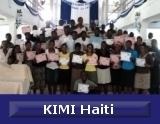
|
Contact UsHaiti 2010Haiti Summer CampsKids Ministry |
home >> haitii>>
haiti geography
Haiti
- Geography  Haiti's terrain consists mainly of rugged mountains with small coastal
plains and river valleys. The country's largest crop-producing and
one of Haiti's most fertile river valleys is the Plaine de l'Artibonite.
The east and central part of the island is a large elevated plateau.
The highest point in Haiti is Pic la Selle at 2,680 m (8,793 feet).
The 360-km (224-mile) border is shared with the Dominican Republic.
Haiti also contains several islands. The famous island of Tortuga
(Île de la Tortue) is located off the coast of northern Haiti.
The arrondissement of La Gonâve is located on the island of
the same name, in the Gulf of Gonave. Gonave Island is moderately
populated by rural villagers. Île à Vache (Island of
The Cow) is located off the tip of southwestern Haiti. It is a rather
lush island with many beautiful sights. Also part of Haiti are the
Cayemites and Ile de Anacaona.
Haiti's terrain consists mainly of rugged mountains with small coastal
plains and river valleys. The country's largest crop-producing and
one of Haiti's most fertile river valleys is the Plaine de l'Artibonite.
The east and central part of the island is a large elevated plateau.
The highest point in Haiti is Pic la Selle at 2,680 m (8,793 feet).
The 360-km (224-mile) border is shared with the Dominican Republic.
Haiti also contains several islands. The famous island of Tortuga
(Île de la Tortue) is located off the coast of northern Haiti.
The arrondissement of La Gonâve is located on the island of
the same name, in the Gulf of Gonave. Gonave Island is moderately
populated by rural villagers. Île à Vache (Island of
The Cow) is located off the tip of southwestern Haiti. It is a rather
lush island with many beautiful sights. Also part of Haiti are the
Cayemites and Ile de Anacaona.
Despite the large environmental crises, Haiti retains a very high amount of biodiversity in proportion to its small size. The country is home to more than 6,000 plants in which 35% are endemic and 220 species of birds in which 21 species are endemic. The country's high biodiversity is due to its mountainous topography and fluctuating elevations in which each elevation harbors different microclimates and its own endemic fauna and flora. The country's varied scenery include lush green cloud forests (in some of the mountain ranges and the protected areas), high mountain peaks, cactus-strewn desert landscapes (due to the deforestation), and palm tree-lined beaches.[21] |
| Copyright © 2018 www.UnitedCaribbean.com All rights reserved. Disclaimer Click to Contact us |



 In
1925, Haiti was a lush tropical paradise, with 60% of its original
forest covering the lands and mountainous regions. Since then, the
population has cut down all but 2% of its forest cover, and in the
process has destroyed fertile farmland soils, while contributing
to desertification.[20] Erosion has been severe in the mountainous
areas. Pictures from space glaringly show the stark difference in
forestation between Haiti and the neighboring Dominican Republic[citation
needed]. Most Haitian logging is done to produce charcoal, the country's
chief source of fuel. The plight of Haiti's forests has attracted
international attention, and has led to numerous reforestation efforts,
but these have met with little success to date.
In
1925, Haiti was a lush tropical paradise, with 60% of its original
forest covering the lands and mountainous regions. Since then, the
population has cut down all but 2% of its forest cover, and in the
process has destroyed fertile farmland soils, while contributing
to desertification.[20] Erosion has been severe in the mountainous
areas. Pictures from space glaringly show the stark difference in
forestation between Haiti and the neighboring Dominican Republic[citation
needed]. Most Haitian logging is done to produce charcoal, the country's
chief source of fuel. The plight of Haiti's forests has attracted
international attention, and has led to numerous reforestation efforts,
but these have met with little success to date.